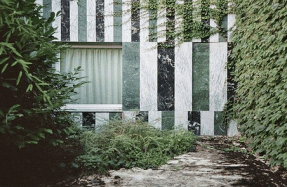SPACE Academia
Research Section on Architectural Theory
Aim of SPACE Academia
SPACE Academia is the Architectural theory research section of SPACE. The section serves to introduce academic papers that enrich and expand the legacy of SPACE, in its search for future directions in ways of thinking about architecture. After being officially listed on the Arts & Humanities Citation Index (A&HCI), SPACE Academia was established in concurrence with its 45th anniversary issue, on November 2011. Blind peer reviews are performed twice by the chief editors and three international reviewers. SPACE Academia looks forward to the emergence of new discourse that can open up new horizons, and renew contemporary intellectual perceptions. SPACE Academia cordially invites the submission of academic papers of a high standard that can diagnose the intellectual potential of our times.
keywords: Readymade, ready-made objects, Le Corbusier, Marcel Duchamp, mechanical equipment, decorative art, type-objects
Nam Sungtaeg is a professor at Hanyang University. He holds a Bachelors of Architecture from Seoul National University, Diplome of Master and Architecte DPLG from École d’architecture de la ville & des territoires Paris-Est in Paris Marne la-Vallée, France and Ph.D. in École Polytechnique Fédérale de Lausanne (EPFL) in Switzerland. In 2019, he conducted research as a visiting scholar at The Institute of Fine Arts, New York University. His major focus is on architecture without any distinction in scale, ranging from object design to urbanism. He is interested in design research concerning theories such as composition, construction, and transformations that are related to the built environments for human life. He translated Précisions sur un état présent de l’architecture (2019). This research was supported by Basic Science Research Program through the NRF funded by the Ministry of Education (NRF-2020R1F1A1076290). It was conducted by deepening and developing some of the contents and topics of the author’s Ph.D. thesis (La question des objets ready-made et son appropriation architecturale) at EPFL. namst@hanyang.ac.kr





Introduction
In architecture, the use of existing solutions has been the inevitable strategy: for example, the use of elements already established with their own tradition or invented by other technological disciplines. In the case of modern architecture, it seems particularly plausible to argue that some architects, such as Le Corbusier, were interested in industrially mass-produced objects. He oriented his thoughts and architectural compositions in such a way so as to resemble the keystone in Marcel Duchamp’s art, the Readymade.
In this paper, I distinguish between the terms ‘ready-made’ and ‘Readymade’. The former, derived from its industrial origin, has an adjective value that indicates ‘all done’ or ‘mass-produced’ in factories. The latter is used to indicate the way in which Duchamp’s artistic endeavours took on a new meaning, as designated by André Breton: ‘an ordinary object elevated to the dignity of a work of art by the mere choice of an artist’ ▼1 . Established in 1913, the Readymade introduced new possibilities in art by allowing an artist to choose a utilitarian object that he did not produce to form his artwork.


However, it was not Duchamp’s pure invention but rather his interpretation. The Readymade as art was made possible by prior awareness of ready-made objects as a modern phenomenon, a sort of Zeitgeist of the ‘found’ within industrial civilization and without a manifesto. As we all know, his visit to the Paris Air Show in 1912 resulted in a desperate confession (‘Painting is dead. Who can do better than this propeller? ▼2 ’ ) and marked a watershed moment in his thinking. Perhaps the purpose of the Readymade was to prove his conversion and to issue a retroactive manifesto on behalf of the phenomenon of ready-made objects, which should have occurred much earlier.
Even if architects embrace mass-produced elements, their acts cannot be equated to Duchamp’s. Moreover, it is not easy to trace the genealogy of his influence on architectural practice. Throughout modern architecture, that contemporaneous with the Readymade and closely associated with other radical arts, architectural historians gave Duchamp little credit. For example, Sigfried Giedion, who was capable of linking aesthetic and technological phenomena, never addressed the Readymade in his seminal ‘Space, Time and Architecture’ (1941) ▼3 .
This is not surprising. Even in the art world at the time, Duchamp’s work was lesser-known, and it was not until after World War II that it began to capture people’s interest. In architecture, it happened much later: Reyner Banham asserted in Theory and Design in the First Machine Age (1960) that Duchamp’s contribution ‘went far beyond anything the Futurists or the Werkbund have achieved up to that time’ ▼4 .
When new avant-garde movements (such as Pop Art, Minimal Art, etc.), notably all heirs to Duchamp, emerged in the art world in the 1960s, their influence on architecture became more explicitly acknowledged in publications. Nevertheless, Readymade’s heritage and its implicit transmission on architecture were seldom investigated.
As such, isn’t it reasonable to hypothesise that a modern architect whose views of objects are based on qualities from Utilitas and Venustas would be interested in Duchamp’s concerns, or, at the very least, easily affected by the phenomenon surrounding the ready-made objects? Doesn’t the artist’s contribution to the promotion of functional objects or elements as a modern aesthetic are contiguous with the fundamental vocations of architects?
For example, a column, stair, or window are originally functional elements that architects seek to ennoble forms through collective tradition or individual contribution. These so-called ‘elements of architecture’ make up the body of the building. Meanwhile, there are diverse objects of use with which the architect or inhabitant fills the interior space: these are furniture and small everyday items, often having been the subject of architectural design under the concept of the Gesamtkunstwerk.
Furthermore, the third group of architectural elements may be classified as mechanical equipment, such as sanitary appliances (reminiscent of Duchamp),
You’re reading a preview, subscribe to read more.
Start your free 30 days





